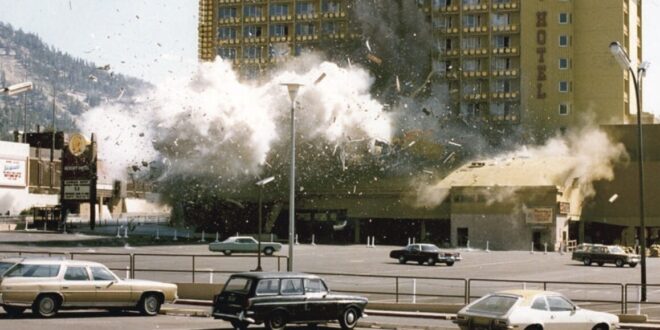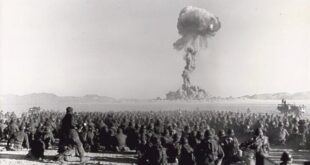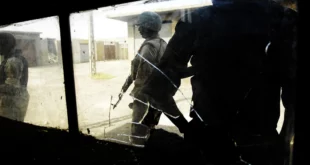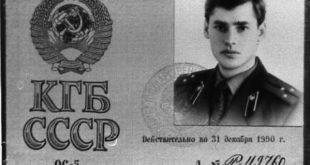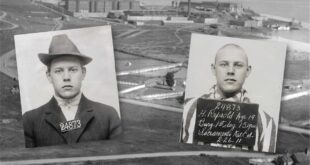by Jose Campos
It started under cover of darkness. In the early hours of an August morning in 1980, three men in white jumpsuits rolled a steel box into Harvey’s Resort Hotel and Casino in Stateline, Nevada. They told casino staff it was an IBM copy machine. It wasn’t. Inside was nearly half a ton of dynamite, surrounded by some of the most diabolically clever booby traps the FBI had ever seen.
What followed was a 30-hour siege, one of the most bizarre criminal cases in U.S. history, and an explosion that leveled a five-story crater into a Lake Tahoe landmark.
The Man Behind the Machine
The architect of the device was John Birges, Sr., a 59-year-old Hungarian immigrant, landscaper, and self-styled inventor with a weakness for high-stakes gambling, according to the FBI. He had lost a fortune at Harvey’s – and he wanted it back.
READ MORE by Jose Campos: Blood on the Highway: The Cartel War to Seize Power in Sinaloa
Birges decided that if the casino wouldn’t return his money willingly, he’d blow the place to hell unless they paid him $3 million in cash.
So he built a bomb.
Not just any bomb, but a homemade IED housed in two steel boxes – one containing nearly 1,000 pounds of dynamite, the other filled with no fewer than eight separate anti-tamper and triggering mechanisms. Inside the resort, Birges made sure the bomb was exactly level, then armed it, the FBI said.
Even the FBI would later admit they had never seen anything quite like it.
“STERN WARNING TO THE MANAGEMENT AND BOMB SQUAD”
The note left atop the box read like something out of a Bond film:
“Do not move or tilt this bomb. The flathead screws are also attached to triggers and as much as ¼ to ¾ of a turn will cause an explosion. This bomb is so sensitive that the slightest movement either inside or outside will cause it to explode. This bomb can never be dismantled or disarmed without causing an explosion. Not even by the creator.”
The box looked like office equipment, draped in gray cloth marked with fake IBM part numbers. Inside, it was a death trap; float switches triggered by flooding, screws wired to explode if turned, aluminum-lined plastic designed to complete a detonation circuit if drilled into, and a pendulum-based tilt switch that would detonate at the slightest jolt.
One false move, and the casino – and much of Stateline – would be rubble.
Countdown to Detonation
Birges had help. Along with his sons and two associates, the bomb was delivered using a custom cart and a staged van with stolen plates. The device was wheeled through Harvey’s lobby, into an elevator, and placed near executive offices.
Then the men disappeared.
When the device was discovered, the FBI and military EOD teams moved in. The building was evacuated, along with other nearby casinos. For hours, experts X-rayed, photographed, and studied the bomb. Eventually, they settled on a plan: use a shaped charge of C-4 to try to sever the control wiring from the explosives.
The charge was set.
The result was catastrophic.
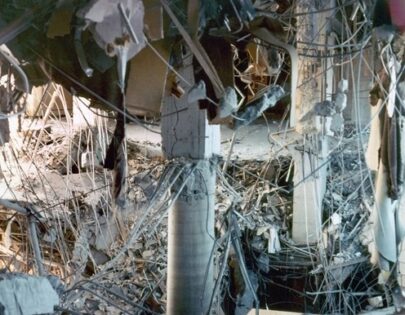
FBI photo.
The bomb exploded with staggering force, vaporizing five floors of the building and leaving behind a smoking crater and the skeletal remains of hotel rooms—TVs dangling from cords, bathroom fixtures ripped from walls, twisted rebar protruding like spears. Miraculously, thanks to the evacuation, no one was killed or injured.
The blast echoed for miles.
Aftermath: The Search for the Mastermind
For weeks, the case dominated headlines. FBI profilers believed the bomb was too advanced for an amateur. They were right.
Investigators followed leads tied to gambling debts and explosives thefts. They determined that Birges had stolen 18 cases of dynamite from a Pacific Gas & Electric facility. His fingerprints were eventually matched. His sons cooperated. Birges, who initially denied everything, later tried to claim he had been forced by mobsters to carry out the attack for insurance fraud.
The jury didn’t buy it.
John Birges, Sr. was convicted of extortion and attempted destruction of a building using explosives. He died in federal prison in 1996. His sons, charged as accomplices, were given suspended sentences for their cooperation.
A Legacy of Lessons
To this day, a mockup of the Harvey’s bomb remains in FBI possession, used as a training tool for bomb techs and federal agents. It is considered one of the most complex improvised explosive devices ever deployed on U.S. soil.
Retired Special Agent Chris Ronay, one of the experts on site that day, remembered the TV sets swinging on electric cords and toilets hanging on by pipes.
“Debris was everywhere,” he said.
The Harvey’s bombing was a wake-up call. It exposed vulnerabilities in casino security, highlighted the dangers of homemade devices, and showcased the dark ingenuity of a man who believed he could hold a resort hostage with a machine no one could defuse.
He almost got away with it.
Jose Campos covers security for Soldier of Fortune.

 Soldier of Fortune Magazine The Journal of Professional Adventurers
Soldier of Fortune Magazine The Journal of Professional Adventurers


